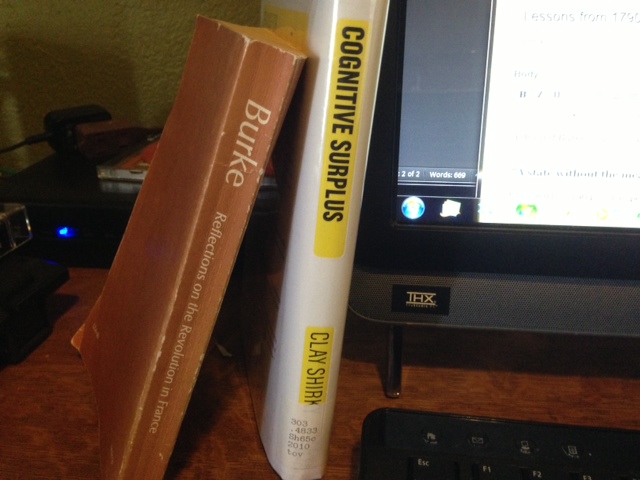In 1790, conservative political philosopher Edmund Burke wrote in Reflections on the Revolution in France:
“A state without the means of some change is without the means of its conservation.”
Clay Shirky, expert on the role of social media and society and author of Cognitive Surplus and Here Comes Everybody, is father of the Shirky Principle:
“Institutions will try to preserve the problem to which they are the solution.”
Burke’s and Shirky’s observations illuminate the current path of much education reform. Policy makers know that public education is currently without the means of change that will ensure its conservation. Yet the solutions with which they encumber us ensure only the preservation of the problems we face.
Student achievement and the No Child Left Behind Act (NCLB) illustrate the point.
It’s hard to disagree with the premise of NCLB – students, teachers and schools should be held accountable to provide a year’s growth for all students, after a year’s instruction. The corollary is that to be held accountable, students, teachers, and schools must be observed.
Yet NCLB’s mechanism of observation preserves rather than ameliorates low student achievement. Teachers spend enormous amounts of time preparing students for standardized tests. But when their attention is focused on testing skills, students are distracted from developing the skills that make them smarter.
Sadly, a school with high scores can only claim that students have achieved mastery of test taking skills. The school can make no claim, based on test results, that its students have grown a year in their creativity, critical thinking, analytical reasoning, abstract reasoning, or any other achievement that an authentic means of observation would reveal.
Conversely, a school with low scores can’t use the current policy to demonstrate the impact it does have.
(Along with perserving the problem, commercial testing services are also surviving. The $1.7 billion spent yearly on standardized testing amounts to less than 1% of the money spent on education, but $660 million of that amount goes to the leading testing service, whose stock price has nearly doubled in the past five years.)
Common Core State Standards are supposed to change everything. The math standards are certainly more demanding than what my students face now. But will students, teachers, and schools be assessed in a manner that measures student growth or in a manner that preserves the problem? The Partnership for Assessment of Readiness for College and Careers (PARCC) is a major player in Common Core assessment and received $186 million from the U. S. Department of Education. I wish I were more encouraged by the time I’ve spent on their website.
Will we ever have a tool that authentically links instruction to achievement – real achievement – the kind students, parents, universities and employers care about?
Here’s just one idea that I would sign onto today. Let me get to know my students for a month. Then, in consultation with parents and students, and based on the Common Core and my contacts with the university and employers, let me develop challenging goals. Give everyone a chance to refine these goals until we reach an agreement. Meet a few times during the year to consult on the kids’ progress and make modifications. At the end of the year we review together whether the students have achieved a year’s worth of growth in what the community cares about. If not, where did we fall short – my instruction, parental involvement, student irresponsibility, or something else? If so, how can we build on our success?
To bring this or any reform to life we must have leaders, including teacher leaders, who meet Edmund Burke’s standards:
“A disposition to preserve and an ability to improve”
and heed Clay Shirky’s warning:
“What’s targeted at me but doesn’t include me may not be worth sitting still for.”
Because as Burke wrote, “Anything else is vulgar in the conception and perilous in the execution.”









